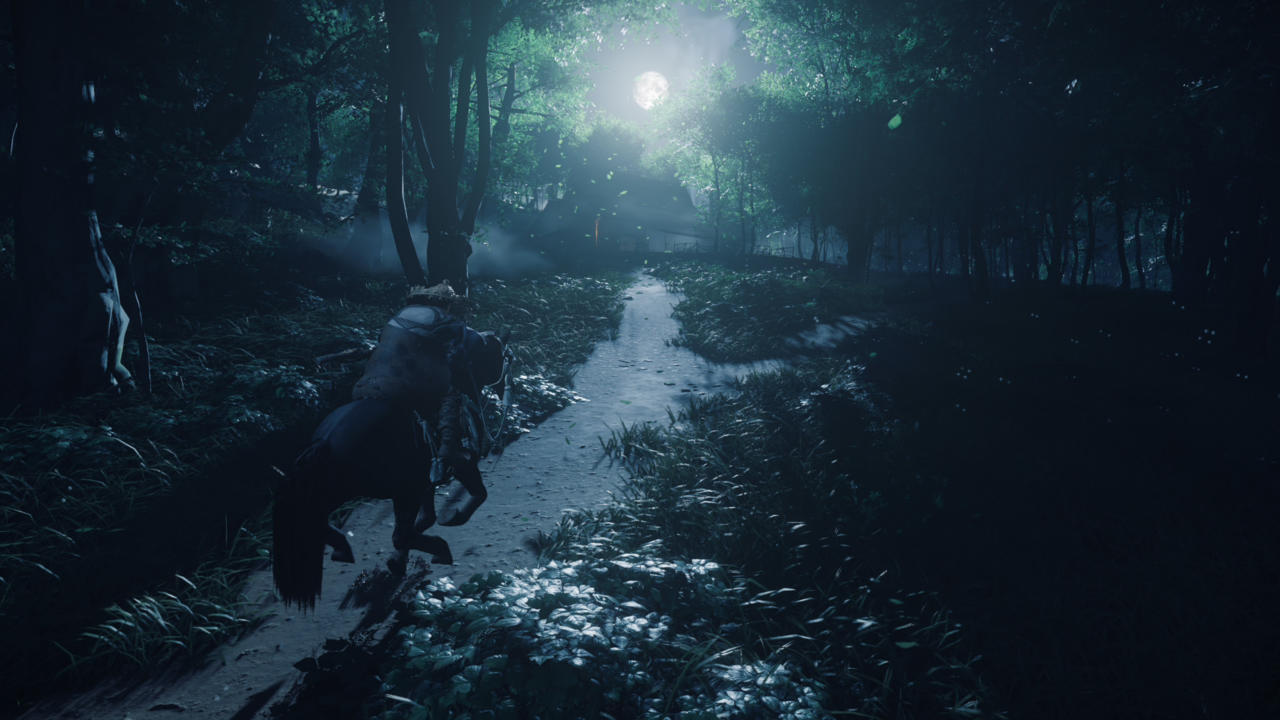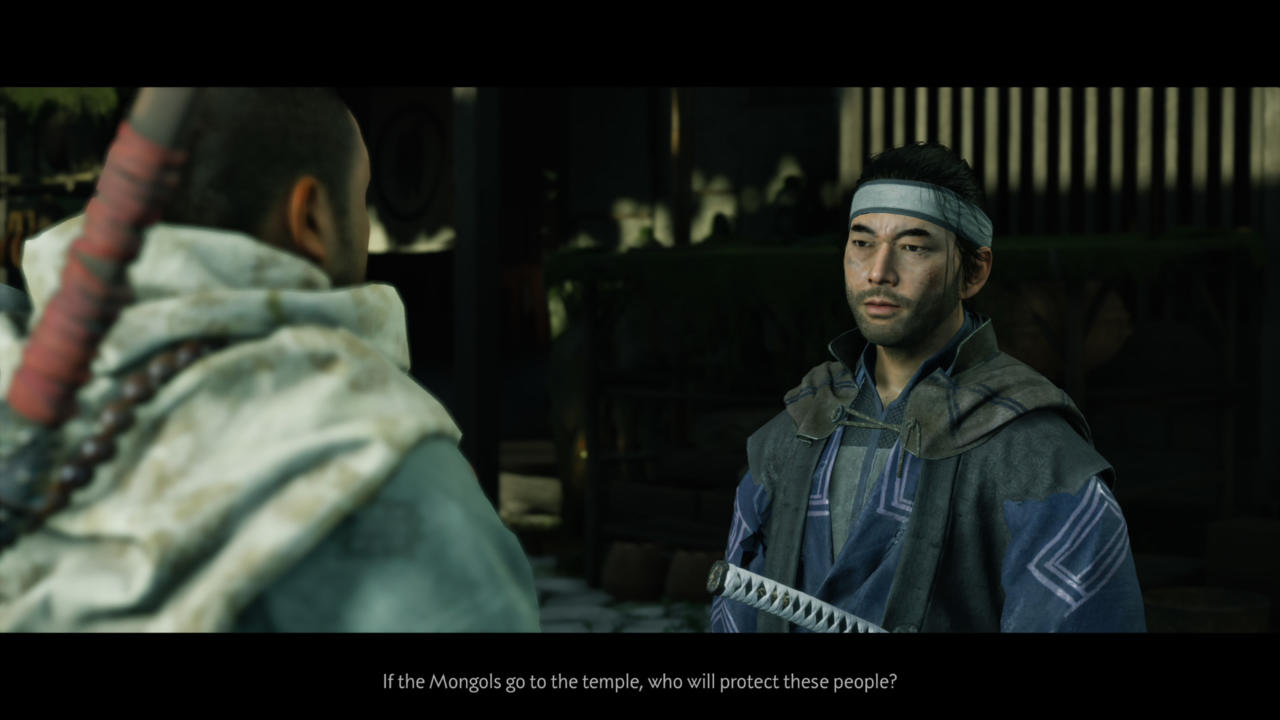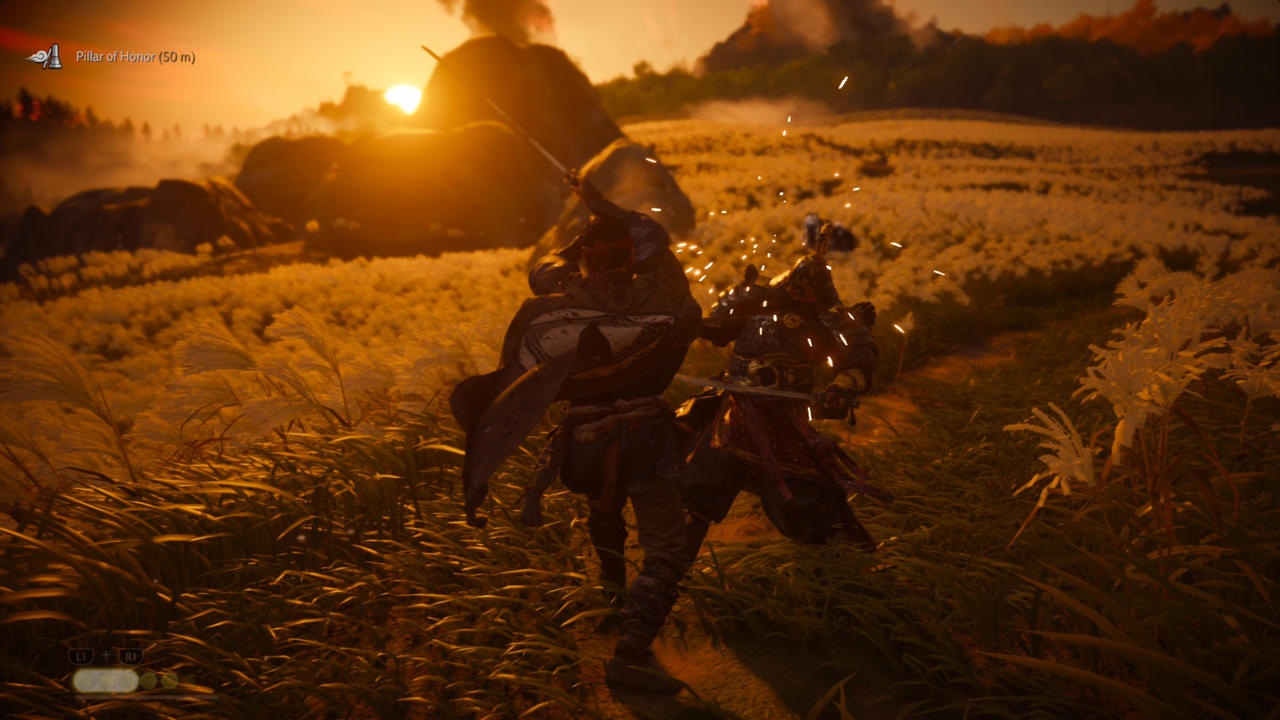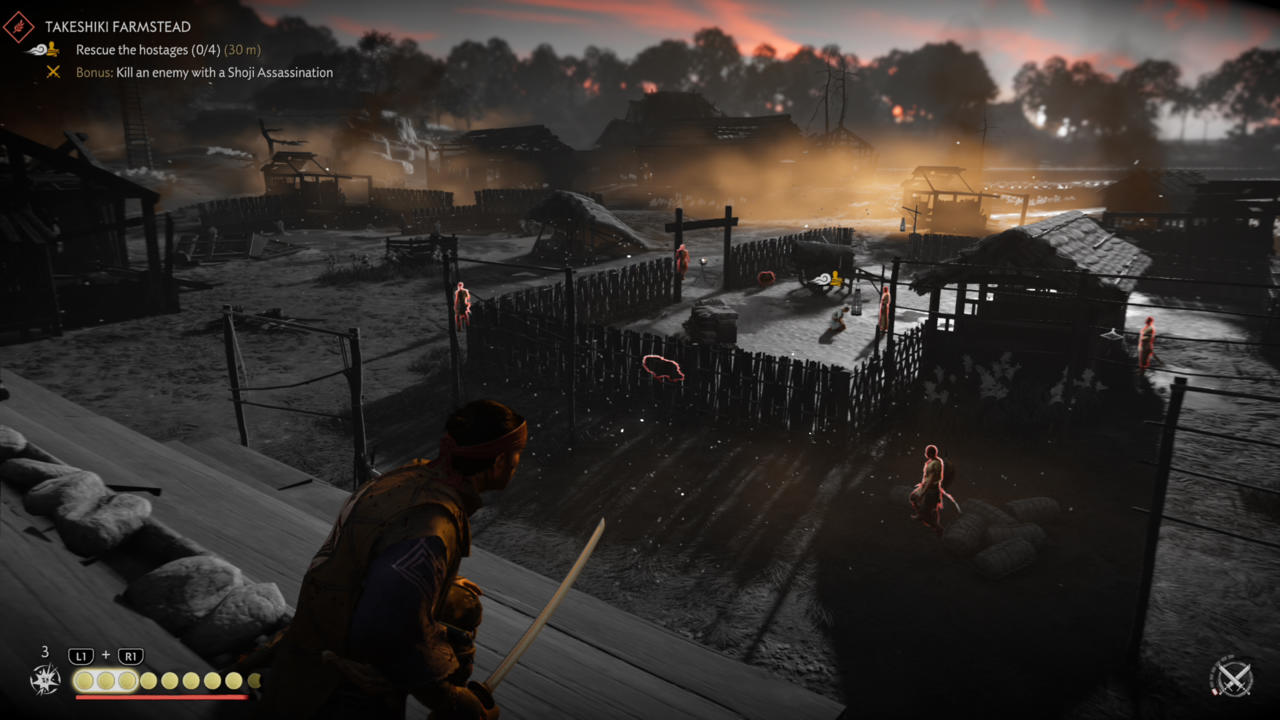If a youthful obsession with Japanese samurai cinema and an audiobook version of Musashi have taught me anything, it's that if you want to be a great swordfighter, having a connection to nature is important. Skill with a weapon isn't purely driven by physical strength and technique, but also by the acuity that comes from observing trees, mountains, and rivers. Something like that.
While I can only make guesses as to how inspirational the rural areas of feudal Japan would have been, the scenic island portrayed in Ghost of Tsushima, an open-world 13th-century samurai epic, is one that often stirs something inside me. Beyond being a game centred around flashy sword fights and the journey of Jin Sakai to becoming a proto-ninja, Ghost of Tsushima invites you to lose yourself deeply in its grasslands, forests, and mountains. And though the tasks you're given often aren't as brilliant as the colour of the leaves, there's certainly something wonderfully humbling about just riding your horse through this beautiful environment and taking it all in.
And what an immediately beautiful world it is, full of bold, saturated colours, grandiose weather effects, and an overabundance of windswept leaves, petals, butterflies, and other small particles that make every location feel alive. The island of Tsushima is a painter's palette; vibrant red and yellow forests sit atop inviting green hills by day, blinding sunsets soak everything in a deep orange. At night, bright white moonlight glistens off dark blue lakes and waterfalls to illuminate everything around you. The game has an option to turn everything black and white in order to mimic the samurai films of Akira Kurosawa, but using it forgoes Tsushima's own distinct visual identity.
At times, it almost feels as if art direction is trying a little bit too hard to draw attention to itself. And Ghost of Tsushima certainly makes a concerted effort to try and absorb you into its radiant world even further with its deliberate lack of navigational information. There's no option for an on-screen minimap or a compass to see which way you're going, and objective markers are barely there. Instead, the game features an in-world device called Guiding Wind, in which the game's plethora of organic particles will subtly fall towards the location of whatever objective you need to reach. A swipe of the DualShock's touchpad will magically and visibly summon a strong gust that kicks up even more particles in an almost comically self-indulgent way, which acts as a more obvious nudge in the right direction.
It's a great system. Without anything to draw your eyes away from your character and the world, the Guiding Wind pushes you to pay more attention to your surroundings, to let you more quickly internalise key landmarks that help you to get your bearings more easily later on, or just to feast your eyes. Other in-world devices, like plumes of smoke, flying songbirds, foxes, Torii gates, talkative non-player characters, and more help to guide (or rather, distract) you toward new activities.
A lot of these activities also work in service of making sure you see Tsushima's good side. Foxes will invite you to follow them down charming paths to nearby Inari shrines. Torii gates will lead you to simple but daring-looking platforming challenges that reward you with spectacular vistas. Haikus ask you to sit down and reflect on your picturesque surroundings. Singing crickets will unlock songs for Jin's flute, which let you magically command the dramatic weather at will. You get equipment early on that helps you track down the game's myriad collectables through the Guiding Wind and controller vibration, and some convenient touches like a generous and very quick-loading fast travel system help make Tsushima be an incredibly pleasant place to move through, especially when armed with the game's robust photo mode to take screenshots with.

While you do need to enter a menu-based world map if you want to go somewhere specific, without a marker to constantly signal your next objective's location, you definitely get a little less obsessed with taking the most direct route, and feel more naturally inclined to just follow winding roads around mountains and along river banks. Guiding Wind creates a flow that gives you plenty of opportunities to drive your own curious exploration. As an open-world device, it also succeeds in masking the feeling that you're simply being strung along by objective markers, even though that's still exactly what you're doing.
That feeling does still come up, unfortunately, when Ghost of Tsushima's quests (referred to as Tales) take hold of the reins. Tales fall back on rote open-world quest structures, where you do things like follow a quest giver to an objective, perhaps having a chat on the way, and veering off the assigned path here isn't allowed. Sometimes you'll be asked to survey or examine an environment, activities which have the ability to devolve into meticulous hunts for interactable hotspots. Some early Tales have you chasing macguffin after macguffin to the point of being silly, making you wonder if anything is going to happen at all. Anytime you're not engaged in combat, a lot of these quests, especially side quests, can feel like a drag.
The cutscenes that host conversations between Jin and other characters, which give context to these Tales, largely feel stilted, which further underscores the tedium. That's not the fault of the acting--Ghost of Tsushima has some passionate and strong-sounding Japanese voice work, at least to my non-speaker ear, though there is a visible disconnect with character lip-syncing, which retains the mocap performances of the (notably all-Asian) English cast. Even though I preferred the Japanese voice audio, the two tracks do offer some differences in regards to their overall tone.

The voice work is largely let down by a noticeable lack of bodily expression in the almost motionless character models, meaning you're basically just watching a couple of talking heads most of the time. That's not uncommon to see in titles of this nature, but it is a significant low point in a game that otherwise hits so many stylistic highs. The cinematography, which frames the characters in pleasing ways within the gorgeous scenery, instead does the heavy lifting to make sure these regular moments are at least somewhat pleasing to the eye--though wide shots do draw more attention to the fact that two conversing bodies are standing perfectly still. This means that a lot of the game's emotional arcs and vibrant characters don't hit as hard as they should. Ghost Of Tsushima clearly aims to evoke golden-age samurai cinema in many ways, but it doesn't manage to capture even a tiny amount of their vigor when it comes to exposition--Mifune-level gusto is completely out of the question here.
There are some exceptions to this. The primary story quests give the characters involved a bit more freedom to move, and naturally benefit from hosting the more interesting plot threads: that of Jin's inescapable metamorphosis from a by-the-books samurai square to something a lot more unscrupulous for the greater good, and how this change affects the relationship with his loving but uncompromising father figure. The combat encounters here also benefit from some great set pieces, heightened by a strong musical score that helps construct those rousing blockbuster moments that always seem to be able to pull at your emotions, no matter how impartial you're trying to be.
Character-specific Tales have a little more to offer too, and see Jin assist his closest allies with their own dire issues. These multi-part questlines can feel like wild goose chases, especially at the beginning of the game, but they all offer their own interesting (and violent) stories of familial bonds, one of the game's major running themes.

Mythic Tales are Ghost Of Tsushima's most interesting quest offering, though they are few in number. These are explorations into the slightly more supernatural elements of the world, featuring their own special animated introductions. They attempt to pull away from the direct point-to-point structure of the other quests by asking you to do things like look at a hand-drawn map and use your own deductive exploration to find the objective location, or perform an activity with a simple mechanical twist. They can still feel like wild goose chases, but the rewards for the more involved nature of them are significant--aside from the main questline, this is your other avenue for earning new types of weapons, armour, and abilities, usually after a climactic one-on-one boss duel.
Those duels, and Ghost of Tsushima's combat in general, is where the game does successfully evoke samurai cinema. Jin's katana remains your primary weapon throughout the whole game; it can fell enemies in a few quick slices, but likewise, Jin can also die quickly after a few good hits from opposing blades. This means blocking, parrying, and dodging are the main skills you need to learn how to both use and overcome properly, and though there is more leeway than something like Sekiro: Shadows Die Twice, battles can still be over in seconds if you make blunders. This gives every fight in the game a degree of heart-pounding tension, from the game's first fight to its final, whether it be a lowly bandit or a master swordsman, even in the otherwise rote quests, and no matter what difficulty you're playing on.
Combat does a fantastic job at approximating the highly-stylised version of one-versus-many sword fighting as seen in films like Harakiri or the Samurai trilogy, where long standoffs and quick, flourished movements mark the ebb and flow of suspense and excitement. Most encounters can be initiated by triggering a one-on-one standoff, a tense game of chicken where you need to wait until your enemy has committed to an attack and then counter it in the split second afterward, dispatching them in one quick fell swoop. Once that formality has passed, enemies will often try to surround you and attack in tandem, and decisive success often depends on patiently waiting for a clear opening for attack, lest you get interrupted by a follow-up blow. Perhaps you might need to wait for an advance so you can perfectly deflect it and counter, or break someone's guard to stagger them with some decisive heavy strikes--indiscriminate flailing will see you thrown off balance quickly. A Resolve meter, charged by defeating enemies, earns you opportunities to perform devastating special attacks or heal yourself, creating small risk-reward decisions to think about. Regularly changing your active fighting stance (each unlocked after encountering enough enemy leaders) to better handle the different kinds of weapons your opponents are wielding adds to the many considerations you need to make, as do ranged opponents and the extra tools you'll eventually have at your disposal as Jin begins to learn more deceitful methods of combat.

Unlike the game's quest cutscenes, Jin's suite of animations, along with the gore and foley associated with combat, do a lot to make the act of sinking a katana into flesh feel meaningful. Flourishes like how Jin returns to stance after a kill, and the graceful movements that accompany a successful parry give everything an observable flow. Switching stances (which slows down time) just before dodging a hit and responding with an advantageous technique feels really good. Taking a step back and watching a video of a good fight you might have just recorded can be like witnessing a well-choreographed action scene. In addition to exploring the world, combat is where Ghost of Tsushima's most transcendent moments lie.
But it's not without flaws; combat is sometimes let down by a couple of major factors. When fighting on uneven terrain like staggered rock formations and inclines, the tightly-interlocked cause and effect of parries and blows starts to unravel, resulting in holes where animations occur but their effects are not passed on. The camera can also be an issue; it should be noted that Ghost of Tsushima does not feature an enemy lock-on function as part of its toolsuite. Presumably, this is because enemies are constantly attacking from all directions, and you should always have the ability to react quickly. But continually having to worry about the camera in order to keep an eye on every enemy within attack range, while also thinking about parrying, executing attack strings, switching stances, dodging ranged projectiles, and keeping your health up so you don't die on the next hit can sometimes be a little much--your right thumb will be moving back and forth between the analog stick and the face buttons more than usual.
When you're fighting in an open, grassy field, and the camera actually pulls back a bit to frame the dozens of enemies closing in on you, Ghost of Tsushima's sword fighting is absolutely sublime. But conditions aren't always perfect. The biggest camera issues regularly arise when fighting in tight spaces indoors, or in cluttered areas like enemy encampments (of which there are many) where tents, fences, crates, and other such environmental objects exist. Too often you will find yourself in a situation where a solid object will be blocking your vision of Jin, your enemies, or more importantly, your enemy's weapons. All enemy attacks have a visible tell, and in the case of stronger, unblockable attacks, they have distinctive red glints moments before they occur. But much like Ogami Itto's Suio-ryu Wave Slicer in the Lone Wolf and Club series (which begins with Itto lowering his sword beneath water--please bear with me here), if you can't see what your enemy is doing with their weapon, there is very little you can do to prevent your imminent death--and that can be incredibly frustrating.
To be fair, you'll also kill people without them ever seeing what you're doing. When Mongol invaders turn up on the coasts of Tsushima, Jin and his honour-stricken samurai cohort find that their new enemies don't play by their overly-formal rules of warfare. Jin very quickly learns to accept that he'll need to adopt more deceitful and vicious tactics to combat the overwhelming occupation of the island, meaning he'll have to get used to hiding in the shadows, stabbing people in the back, and using a variety of tools to give himself an unfair advantage--warfare tactics that were reportedly unheard of in 13th-century Japan.
A viable option in most scenarios, stealth is a relatively uncomplicated affair in Ghost of Tsushima. Enemies are often placed in convenient locations and are hard of hearing (nearby neutral NPCs will, hilariously, react dramatically to your actions while enemies stand motionless). In the beginning, it also feels basic to a fault--I remember lamenting the fact that there was no way to hide bodies, even though guards are alerted upon discovering them.
But as you quickly earn new Ghost Tools to use and upgrade your Tanto blade for quicker takedowns, it becomes clearer that it isn't a stealth game focussed on barely slipping by unnoticed (though there are a number of annoying instant-fail stealth and tailing quests), but one where you want to see how quickly and viciously you can take down everyone in the vicinity. That ended up justifying the inability to hide bodies, on top of explaining why Jin's footsteps are silent to begin with, and how he managed to already be a fearless climbing master. Even after I had completed the game's main quest, I gained a lot of enjoyment from using the remaining enemy encampments as playgrounds to terrorize soldiers. I'd get creative with distraction tools, use more environmental kills, turn enemies against one another with hallucinogenic darts, and hone my super long-range grenade throwing arm from the safety of a dark rooftop I clambered onto with a grappling hook.

Ghost of Tsushima's story hits hard in the game's third and final act, and ends in spectacular fashion. It left me with the same kinds of strong emotions I felt at the end of all my favourite samurai film epics, and had me eager to watch them all again. The game hits a lot of fantastic cinematic highs, and those ultimately lift it above the trappings of its familiar open-world quest design and all the innate weaknesses that come with it--but those imperfections and dull edges are definitely still there. Ghost of Tsushima is at its best when you're riding your horse and taking in the beautiful world on your own terms, armed with a sword and a screenshot button, allowing the environmental cues and your own curiosity to guide you. It's not quite a Criterion classic, but a lot of the time it sure looks like one.
Ghost Of Tsushima is featured as one of the best PS5 games.









